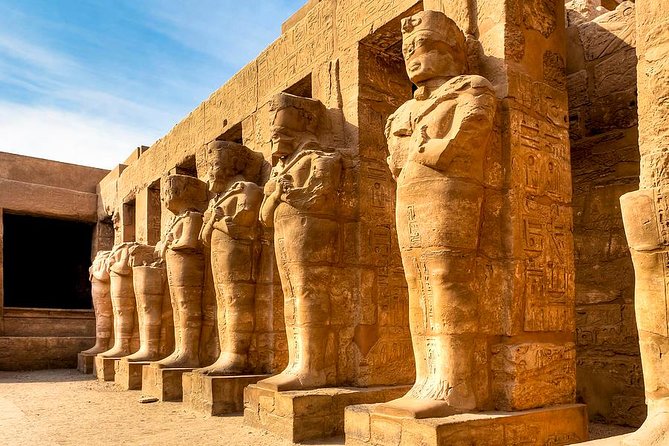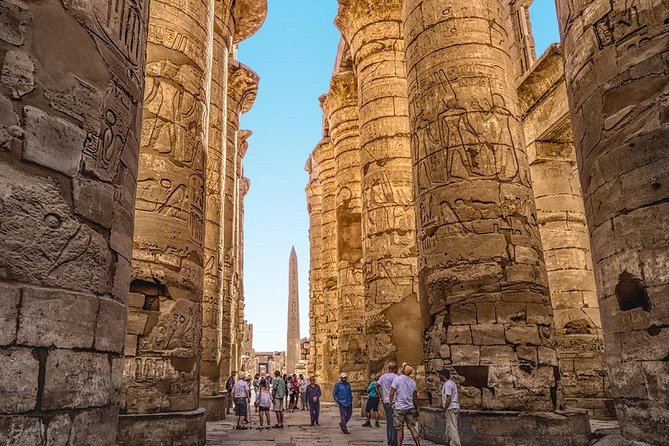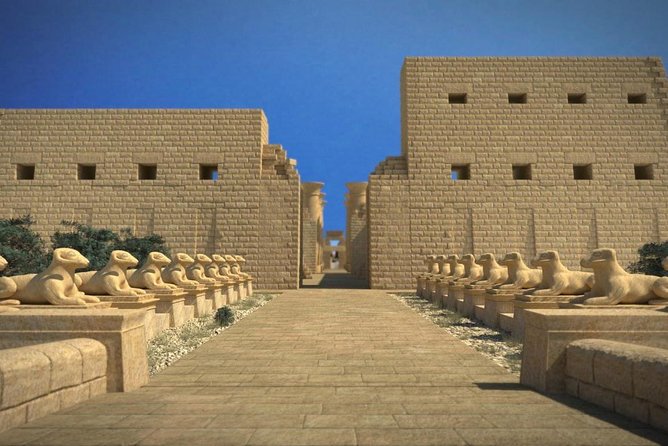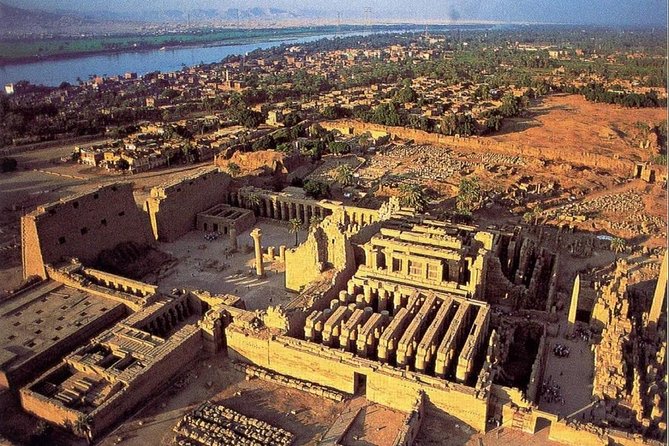Unravel the mysteries of Luxor’s East Bank as you step back in time to explore the remnants of an ancient civilization.
The bustling streets of Luxor Corniche lead the way to a world where pharaohs ruled and gods walked among mortals.
From the imposing Luxor Temple to the sprawling Karnak Temple Complex, each site whispers tales of a bygone era waiting to be deciphered.
But what hidden secrets lie within the walls of these majestic structures, and what untold stories will be unveiled along the journey?
Good To Know

- Luxor Temple and Karnak Temple Complex showcase ancient Egyptian grandeur and religious practices.
- Luxor Museum offers well-preserved artifacts for a deeper understanding of ancient Egyptian history.
- Avenue of Sphinxes connects the temples, symbolizing strength and wisdom.
- Luxor Corniche provides a vibrant waterfront experience with Nile views and cultural insights.
Luxor Temple

Located in the heart of Luxor, Egypt, Luxor Temple stands as a magnificent testament to ancient Egyptian architectural prowess and religious significance. These ancient ruins date back to around 1400 BC and were dedicated to the rejuvenation of kingship and used for the worship of the god Amun.
As visitors explore the temple complex, they’re greeted by the imposing first pylon, leading to a vast courtyard surrounded by impressive colonnades and statues. The avenue of sphinxes that once connected Luxor Temple to Karnak Temple Complex showcases the grandeur of this historical site.
The temple’s intricate hieroglyphic inscriptions and well-preserved structures offer a glimpse into the rich history and religious practices of ancient Egypt.
Find more activities and experiences we've covered in Luxor.
Karnak Temple Complex

Nestled on the east bank of the Nile River in Luxor, Egypt, the Karnak Temple Complex stands as a monumental symbol of ancient Egyptian grandeur and religious devotion. Exploration of this vast complex unveils a stunning display of intricate architecture, colossal statues, towering pillars, and beautifully adorned walls.
The complex is a masterpiece of ancient construction, with each section showcasing different architectural styles and historical significance. Visitors can marvel at the Great Hypostyle Hall, a forest of towering columns, and the sacred lake used for ritual purposes.
The Karnak Temple Complex offers a remarkable opportunity to take in the awe-inspiring beauty and spiritual significance of ancient Egyptian architecture.
Luxor Museum

The Luxor Museum showcases a fascinating collection of ancient Egyptian artifacts, providing visitors with a captivating insight into the rich history and culture of the region.
The museum, located near the Karnak Temple Complex, houses a variety of well-preserved items dating back to different periods of ancient Egypt. Visitors can admire statues, jewelry, pottery, and other relics that offer a glimpse into the daily life, beliefs, and artistic achievements of the ancient Egyptians.
One of the highlights of the museum is the beautifully displayed mummies and sarcophagi, giving a unique perspective on ancient burial practices.
The Luxor Museum is a must-visit for history enthusiasts and anyone looking to delve deeper into the wonders of ancient Egypt.
Avenue of Sphinxes
Visitors exploring the wonders of Luxor’s East Bank will be captivated by the breathtaking Avenue of Sphinxes, a majestic pathway that once connected the famous Karnak Temple to the Luxor Temple, showcasing a remarkable display of ancient Egyptian grandeur and symbolism.
| Avenue of Sphinxes |
|---|
| Sphinxes Restoration |
| The Avenue of Sphinxes is currently undergoing a meticulous restoration process to preserve these iconic mythical creatures that line the path. |
| Archaeological Significance |
| This avenue holds immense archaeological significance, providing insights into the religious and ceremonial practices of the ancient Egyptians. The sphinxes symbolize strength, wisdom, and protection in Egyptian mythology. |
The ongoing restoration efforts aim to ensure that future generations can continue to marvel at this historical marvel.
Luxor Corniche
Meandering along the eastern bank of the Nile River in Luxor, the Luxor Corniche offers a picturesque promenade where the city’s vibrant culture and stunning river views converge. Visitors can enjoy leisurely strolls along the riverside, taking in the bustling activity of local vendors and the serene beauty of the Nile.
The Corniche is also a popular spot for embarking on relaxing Nile cruises, allowing guests to see Luxor from a different perspective while gliding along the tranquil waters. After a scenic cruise, travelers can indulge in the rich flavors of local cuisine available at charming cafes and restaurants lining the Corniche.
From traditional Egyptian dishes to international fare, there’s a culinary delight for every palate along this vibrant waterfront promenade.
Mummification Museum

Nestled on Luxor’s East Bank, the Mummification Museum offers a fascinating glimpse into the ancient Egyptian practice of preserving the deceased.
- Watch intricate mummification techniques demonstrated through ancient tools and artifacts.
- Explore the historical significance of mummification in Egyptian culture, understanding its religious and social importance.
- View well-preserved mummies of various animals, showcasing the breadth of mummification practices beyond humans.
The museum provides a detailed insight into the meticulous process of mummification, shedding light on the beliefs and rituals surrounding death in ancient Egypt.
Visitors can marvel at the craftsmanship involved and gain a deeper understanding of this sacred practice that played a central role in Egyptian society for centuries.
Luxor Market
The vibrant bustle of Luxor Market beckons with its array of colorful stalls and aromatic spices, offering visitors an immersive experience into the local culture and trade scene. Located in the heart of Luxor, this bustling market is a treasure trove for those seeking authentic Egyptian goods and local cuisine.
Visitors can meander through the narrow alleyways lined with vendors selling everything from vibrant textiles and traditional handicrafts to exotic spices and fragrant oils. The market is also a haven for foodies, with stalls offering a tantalizing array of street food and traditional dishes like koshari, falafel, and delicious kebabs.
Exploring Luxor Market isn’t just a shopping experience but a journey into the rich tapestry of Egyptian life and culinary traditions.
Frequently Asked Questions
What Is the Best Time of Day to Visit the East Bank in Luxor to Avoid Crowds?
The best time of day to visit the east bank in Luxor to avoid crowds is early morning or late afternoon. These times offer optimal lighting for photography and fewer travelers, making it ideal for capturing the best photography spots.
Are There Any Recommended Local Restaurants or Cafes Near the East Bank Attractions for Lunch or Snacks?
For those exploring the East Bank in Luxor, they can discover local cuisine gems tucked near attractions. These hidden restaurants and cafes offer delicious meals and snacks, providing a taste of authentic flavors while avoiding crowded tourist spots.
Can Visitors Take Photos Inside the Luxor Museum and Karnak Temple Complex?
Visitors can take photos inside the Luxor Museum and Karnak Temple Complex, but it’s essential to respect photography etiquette and any restrictions in place. Capturing these sites’ cultural significance while preserving their heritage is crucial for future generations to appreciate.
Are There Any Specific Dress Code Requirements for Visiting the East Bank Sites?
Visitors exploring the East Bank sites in Luxor should adhere to respectful dress code requirements. Modest attire, covering shoulders and knees, is recommended out of cultural etiquette. It’s essential to dress appropriately to show respect for the sites.
Are There Any Special Events or Festivals That Take Place in Luxor That Travelers Should Be Aware of When Planning Their Visit to the East Bank Attractions?
Travelers visiting Luxor should be aware of cultural celebrations and local markets. These events offer insights into Egyptian traditions and provide opportunities to immerse in the vibrant local culture. Time your visit to experience these enriching experiences.
The Sum Up
To sum it up, a tour of Luxor’s East Bank offers a mesmerizing journey through ancient wonders, rich in history and cultural significance. From the majestic Karnak Temple to the grandeur of Luxor Temple, visitors are treated to a captivating experience that brings the past to life.
With expert guides, seamless logistics, and unforgettable sights, this tour promises to leave a lasting impression on all who embark on this enlightening adventure.
More Tours in Luxor
More Tour Reviews in Luxor
Looking for something different? Other Luxor activities we've written about
- Private Half Day Tour West Bank of the Nile Luxor Egypt
- 18 Best Shopping Tours In Luxor
- 5 Best Workshops And Classes In Luxor
- 21 Best Sailing Experiences In Luxor
- 20 Best Historical Tours In Luxor
- 20 Best 3 Day Tours In Luxor
- 16 Best Snorkeling Experiences In Luxor
- 25 Best Boat Tours And Cruises In Luxor
- 20 Best 4 Day Tours In Luxor
- 20 Best Private Driver Services In Luxor
- 6 Best 3 Hour Tours and Experiences in Luxor
- 20 Best Full-Day Tours In Luxor
